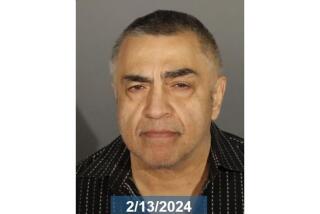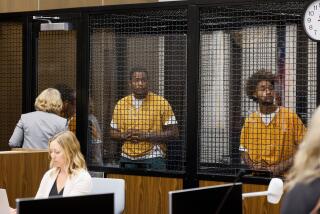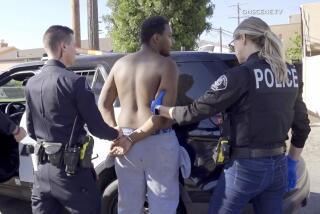Slaying Suspect Caught Years After Fake Suicide
- Share via
Hugh “Randy” McDonald seemed to have it all--a lucrative law practice, a loving family and a beautiful house near the ocean in Newport Beach--when he suddenly disappeared four years ago, just as police were about to question him as a suspect in a woman’s death.
Within days, they found his car, some clothes and a business card on the edge of the Golden Gate Bridge. He had mailed home a videotape as a “final farewell” to his wife and three children.
But Thursday evening, McDonald, very much alive, was marched out of a modest Reseda home in handcuffs, ending what authorities describe as an astonishing vanishing act with more twists than a Hollywood thriller.
McDonald had bounced from state to state, detectives said, changing identities as he went. He would scan obituaries in local newspapers so he could assume the identity of the recently dead; he lost weight and shaved his head to alter his appearance, according to police.
By the time the pursuit ended, McDonald was a gaunt, bald version of the man whose disappearance shocked Orange County’s tight legal circles.
His arrest capped an intensive manhunt by Orange County sheriff’s detectives, who allege that in 1997 McDonald knocked on the door of an upscale hillside home, then chased a woman around the house before opening fire as her maid and children ran out a back door.
Authorities have no idea why the killer targeted the woman, Janie Pang. One of their few clues is that McDonald’s law firm did work for a company owned by Pang’s husband.
Early in the case, authorities thought Pang’s killer might be a man who once stalked her, but that theory was later discounted. Now, they allege that McDonald was trying to rob the house.
Detectives are also unsure about what relationship--if any--McDonald and Pang had before the killing.
McDonald had help while he was in hiding--and that’s how he was caught.
Authorities suspect that friends deposited money in a San Fernando Valley bank account. They learned of the account earlier this week and were able to track McDonald down by reviewing bank surveillance videos. The tapes showed a woman, subsequently identified as Chrystel Lepelletier of Reseda, withdrawing $1,500. Police discovered McDonald hiding at her house.
McDonald, 52, who is being held at the Orange County jail, declined on Friday to talk to reporters. Lepelletier said in an interview as she was released from jail that McDonald was an innocent man who was framed for the killing.
“He knew that he didn’t do anything wrong,” Lepelletier said. “He thought the world was against him.”
His friends and former colleagues insist that the man they knew as a hard-working, buttoned-down attorney bears little resemblance to the portrait of a scheming killer presented by authorities.
“He’s a highly intelligent, thoughtful, skilled attorney with impeccable credentials,” said Brian Murphy, a Los Angeles attorney and former colleague of McDonald. “He would be the last person you would ever expect to be involved in something like that.”
Gunman Confronts Stay-at-Home Mother
The shooting occurred in the wealthy Orange County suburb of Villa Park. Janie Pang had moved there in 1995 with her husband, Danny, and her three children, two from a previous marriage. A former topless dancer, she now spent her time as a stay-at-home mother, volunteering at her children’s school and tending zealously to her rosebushes, Friends and relatives said.
On May 30, 1997, a maid at the Pangs’ home opened the front door to a clean-cut man with a pencil-thin mustache and wearing a business suit. Inside, the man talked casually with Pang for a few minutes, then drew a pistol, deputies said.
As the terrified maid spirited two of the children away, the gunman chased Pang through the house. She ran into a bedroom, where the gunman caught up with her.
A sketch of the killer ran in newspapers and on television, and the drawing bore a striking resemblance to McDonald, investigators said. When they discovered the connection between his law firm and the Pangs, detectives began considering the lawyer as a possible suspect.
Before they could contact him, McDonald flew to San Jose, where, he had told his wife, Caren, he had a business meeting. He called to say he had arrived.
It was June 5, the last time his family would talk to him.
The next morning, his wife received a Federal Express package. It contained a loving letter from her husband, all the family’s important documents, including the deed to their home, and a book on how to commit suicide.
Caren McDonald called her husband’s hotel, but was told he had checked out. The next day, a jogger on the Golden Gate Bridge found a watch with a business card attached. A note on the card said the watch should be returned to McDonald’s wife, who had purchased it for him. McDonald’s wallet was found in nearby bushes. A car he had rented was abandoned in the parking lot.
But his body was never found, and family members did not believe he had committed suicide.
Homicide detectives in Orange County, who suspected him in the Pang killing, also suspected that he was still alive.
Then a call came in from Salt Lake City, where police were investigating a tip that a newly arrived lawyer named Robert Belmont was actually McDonald.
Orange County deputies flew to Utah to bring the man back, but they just missed him. As the years passed, detectives received word of numerous sightings from across the country, but were never able to pinpoint where McDonald was staying.
About a year ago, McDonald reached out to some former law associates for help, according to several friends.
Tom Malcolm, who had worked with McDonald at the law firm Jones, Day, Reavis & Pogue, said he got a call from his old friend about a year ago, seeking advice.
“He was just in horrible condition,” Malcolm recalled. “He felt that he was persona non grata. And I said, ‘Randy, there are a lot of people out there who have a lot of compassion for you and want to help you.’ ” McDonald told Malcolm he needed an attorney. Malcolm said he had no idea at the time that McDonald was wanted for murder. McDonald never called back, Malcolm said, and never asked him for money.
At about the same time, detectives were trying to put together a case against the fugitive attorney. Armed with new evidence they declined to disclose, detectives convinced prosecutors last month to seek a murder warrant.
Search Finally Ends at a Home in Reseda
The trail finally ended on a tree-lined street in Reseda where the woman withdrawing money from McDonald’s account lived. Police arrested McDonald on the murder warrant and Lepelletier on suspicion of harboring a fugitive and assaulting an officer.
Lepelletier, 48, kicked one of the investigators and had to be wrestled to the floor, deputies said. Neighbors said they saw her being dragged into a police cruiser, shouting that officers had arrested the wrong man.
Lepelletier said Friday that she befriended McDonald in December 1997, when they both were staying at a Los Angeles motel.
She recalled McDonald lying on the floor of the motel room, surrounded by pictures of his family, crying as he thought about the three children he had left behind.
He told her that he had been framed for a murder, Lepelletier said. “He knew that he didn’t do anything wrong,” she said. “He thought the world was against him.” She said McDonald frequently stayed at the homes of friends and received some type of government check that was deposited in his bank account.
In the four years since the shooting, McDonald’s wife, Caren, has remarried. She could not be reached for comment, but her father said he was stunned at the accusation being made against a man who was her sweetheart at Fullerton’s Sunny Hills High School.
Said Jack Bishop. “I just absolutely cannot believe it. . . . I can’t believe he could do it.”
*
Times staff writer Kristina Sauerwein contributed to this story.
More to Read
Sign up for Essential California
The most important California stories and recommendations in your inbox every morning.
You may occasionally receive promotional content from the Los Angeles Times.














